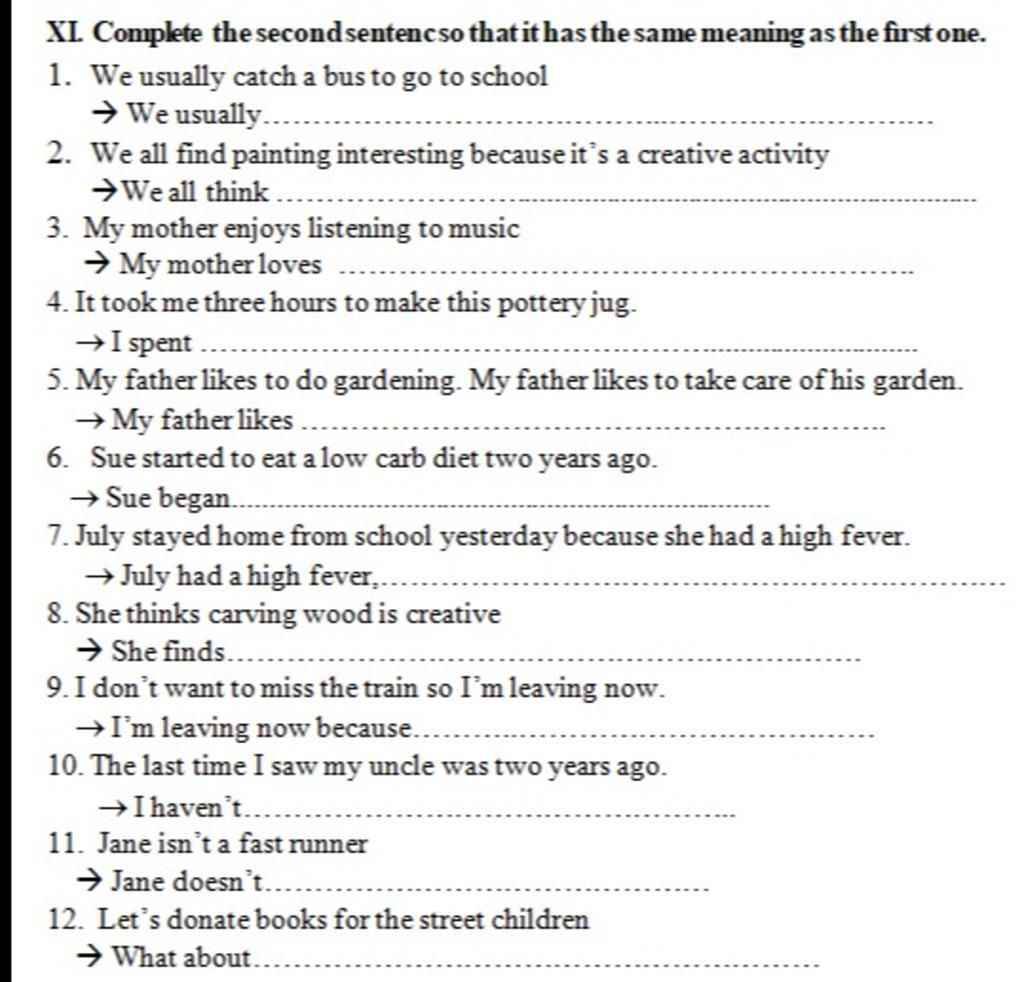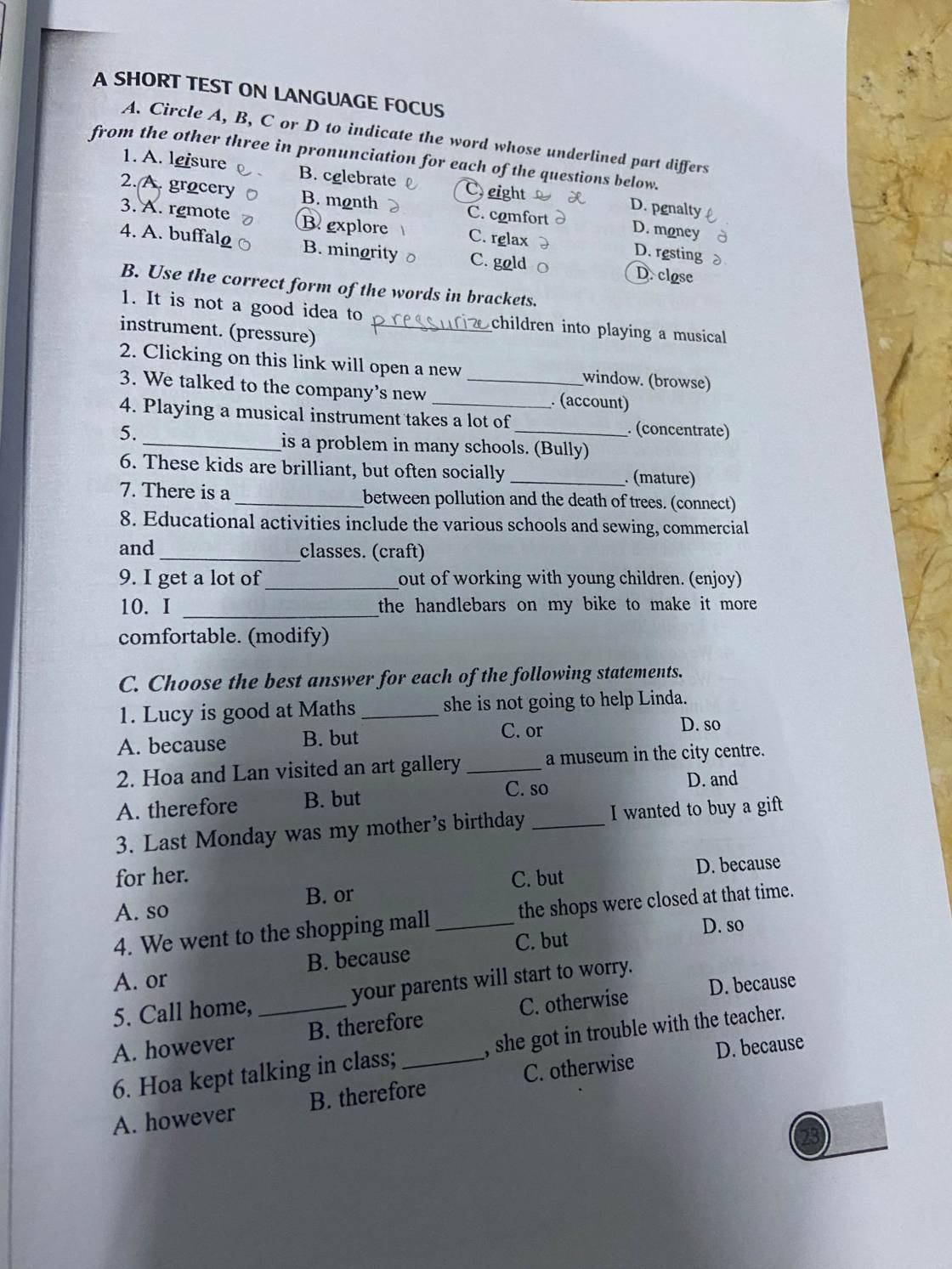English (speak). all over the world
Hãy nhập câu hỏi của bạn vào đây, nếu là tài khoản VIP, bạn sẽ được ưu tiên trả lời.


1 We usually go to school by bus
2 We all think painting is interesting because it is a creative activity
3 My mother loves listening to music
4 I spent three hours making this pottery jug
5 My father likes doing gardening
6 Sue began eating a low carb diet two years ago
7 July had a high fever, so she stayed home from school yesterday
8 She finds carving wood creative
9 I'm leaving now because I don't want to miss the train
10 I haven't seen my uncle for 2 years
11 Jane doesn't run fast
12 What about donating books for the street children

1 pressurize
2 browsing
3 accountant
4 concentration
5 bullying
6 immature
7 connection
8 crafting
9 enjoyment
10 modified
C
1 B
2 D
3 A
4 B
5 C
6 B


Phủ định:
(-) S + tobe(am/is/are) + not + Vthường ( với động từ tobe )
(-) S + don't/doesn't + Vthường ( với động từ thường )
↓
Nghi vấn:
(?) Tobe( Am/Is/Are) + S + N/adj ... ( với động từ tobe )
(?) Do/Does + S + V ... ( với động từ thường )

1. Can you turn on the light please?
2. Would you like to have a picnic next Sunday?

Title: A Guide to Making Your School Greener
Introduction: Welcome to our guide on how to make your school greener! By implementing sustainable practices, you can contribute to a cleaner environment and create a positive impact on the planet. In this guide, we will provide you with practical steps to help you and your school become more eco-friendly.
1. Reduce Paper Usage:
Encourage digital communication: Promote the use of emails, online platforms, and shared documents instead of relying on paper-based communication.
Opt for electronic assignments: Encourage teachers to accept electronic submissions for assignments, reducing the need for printed papers.
Utilize both sides of the paper: Encourage students and staff to print on both sides of the paper whenever possible.
2. Implement Recycling Programs:
Set up recycling stations: Place recycling bins strategically throughout the school to make it convenient for everyone to recycle paper, plastic, glass, and other recyclable materials.
Educate on proper recycling: Provide clear instructions on what can and cannot be recycled, ensuring that everyone understands the recycling process.
3. Conserve Energy:
Turn off lights and electronics: Remind students and staff to switch off lights, computers, and other electronic devices when not in use.
Utilize natural lighting: Make the most of natural light by opening curtains and blinds, reducing the need for artificial lighting during the day.
Upgrade to energy-efficient appliances: Encourage the school administration to invest in energy-efficient appliances and LED lighting, reducing energy consumption.
4. Promote Water Conservation:
Fix leaks and drips: Address any leaks or drips in faucets, toilets, or other water fixtures promptly to prevent wastage.
Encourage shorter showers: Raise awareness about the importance of shorter showers to conserve water and encourage students to be mindful of their water usage.
Collect rainwater: Install rain barrels to collect rainwater for watering school gardens or other non-potable uses.
5. Develop Green Spaces:
Start a school garden: Set up a garden where students can learn about sustainable gardening practices and grow their food.
Plant native trees and plants: Native plants require less water and maintenance, while also providing habitat for local wildlife.
Create green roofs: Implement green roofs or living walls to improve insulation and reduce energy consumption while enhancing the aesthetic appeal of the school.
Conclusion: By following these steps, you can make your school a greener and more sustainable place. Remember, small changes can have a significant impact when everyone in the school community works together towards a greener future. Start implementing these practices today and lead the way in creating a more environmentally conscious school environment.



English is spoken all over the world.